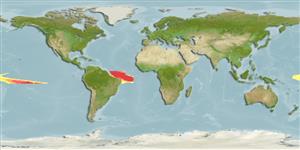>
Argentiniformes (Marine smelts) >
Microstomatidae (Pencil smelts)
Etymology: pelagica: From its pelagic life.
Eponymy: Fridtjof Nansen (1861–1930) was a Norwegian explorer, scientist, diplomat and later recipient of the Nobel Peace Prize. [...] (Ref. 128868), visit book page.
Environment: milieu / climate zone / depth range / distribution range
Écologie
marin; profondeur 0 - 2000 m (Ref. 58302). Tropical; 15°N - 10°S
Southwest Atlantic, and western to eastern Central Pacific.
Taille / Poids / Âge
Maturity: Lm ? range ? - ? cm
Max length : 10.8 cm SL mâle / non sexé; (Ref. 5123)
Description synthétique
Clés d'identification | Morphologie | Morphométrie
Rayons mous dorsaux (Total) : 9 - 10; Rayons mous anaux: 8 - 9; Vertèbres: 38 - 39. Branchiostegal rays 4. Head longer than N. atlantica, 27-30% SL. A dark pigment spot on the gular area that becomes obscure with growth in specimens larger than 9 cm SL (Ref. 5123).
Mesopelagic (Ref. 58302).
Life cycle and mating behavior
Maturité | Reproduction | Frai | Œufs | Fécondité | Larves
Kawaguchi, K. and J.L. Butler, 1984. Fishes of the genus Nansenia (Microsomatidae) with descriptions of seven new species. Los Angeles County Mus. Contr. Sci. 352:1-22. (Ref. 5123)
Statut dans la liste rouge de l'IUCN (Ref. 130435: Version 2024-1)
Menace pour l'homme
Harmless
Utilisations par l'homme
Outils
Articles particuliers
Télécharger en XML
Sources Internet
Estimates based on models
Preferred temperature (Ref.
123201): 5.9 - 11.1, mean 8.6 °C (based on 6 cells).
Phylogenetic diversity index (Ref.
82804): PD
50 = 0.5000 [Uniqueness, from 0.5 = low to 2.0 = high].
Bayesian length-weight: a=0.00389 (0.00180 - 0.00842), b=3.12 (2.94 - 3.30), in cm total length, based on all LWR estimates for this body shape (Ref.
93245).
Niveau trophique (Ref.
69278): 3.2 ±0.4 se; based on size and trophs of closest relatives
Fishing Vulnerability (Ref.
59153): Low vulnerability (10 of 100).
